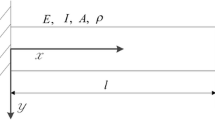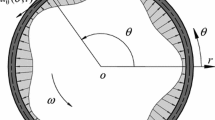Abstract
This paper describes the structural behavior of a permanent magnet synchronous machine (PMSM), used to propel a light electric vehicle, namely an electric scooter. The motor’s topology is with outer rotor (in-wheel motor). Since the rotor and the stator iron cores are under electromagnetic force influence, both parts have their own influence on the overall behavior of the PMSM, and for this reason, here they will be separately analyzed. This analysis is carried out in order to observe the mode shapes of the PMSMS, involved by radial forces. These mode shapes represent, in part, the image of the vibration and noise produced by the PMSM. The analysis is carried out by using LMS Virtual.Lab software; with this tool, based on appropriate discretization, one can investigate, on a larger frequency range, the mode shapes of the PMSM’ structure. Next, the experimental mode shapes are experimentally evaluated by performing the so-called impact testing. The comparison of the numerical and experimental results depicts the consistency of the research and indicates the behavior of the studied structure in specific operating conditions.














Similar content being viewed by others
References
Pop CV, Fodorean D, Husar C, Irimia C (2018) Structural numerical and experimental comparison of an in-wheel motor dedicated for electric scooter application. ELEKTRO, Mikulov, Czeck Republick, 21–23 May 2018, paper TCP3-15, pp. 1–5. https://doi.org/10.1109/elektro.2018.8398293
Marouani K, Nounou K, Benbouzid M, Tabbache B (2018) Investigation of energy-efficiency improvement in an electrical drive system based on multi-winding machines. Electr Eng 100:205–216. https://doi.org/10.1007/s00202-016-0493-z
Fodorean D, Viorel IA, Djerdir A, Miraoui A (2008) Performances for a synchronous machine with optimised efficiency while wide speed domain is attempted. IET Electr Power Appl 2(1):64–70. https://doi.org/10.1049/iet-epa:20070289
Hruska K, Kindl V, Pechanek R (2017) Design of a high-speed permanent magnet synchronous motor for electric kart. Electr Eng 99:1141–1150. https://doi.org/10.1007/s00202-017-0623-2
Shenbo Y, Tang R (2006) Electromagnetic and mechanical characterizations of noise and vibration in permanent magnet synchronous machines. IEEE Trans Magn 42(4):1335–1338. https://doi.org/10.1109/TMAG.2006.871637
Wrobel R, Lukaniszyn M, Jagiela M, Latawiec K (2003) A new approach to reduction of the cogging torque in a brushless motor by skewing optimization of permanent magnets. Electr Eng 85(2003):59–69. https://doi.org/10.1007/s00202-002-0144-4
Salah WA et al (2015) Implementation of PWM control strategy for torque ripples reduction in brushless DC motors. Electr Eng 2015(97):239–250. https://doi.org/10.1007/s00202-014-0329-7
Bahri E, Pusca R, Romary R, Belkhayat D (2018) A new approach for torque ripple reduction in a faulty surface permanent magnet synchronous motor by inverse current injection. Electr Eng 100:565–579. https://doi.org/10.1007/s00202-017-0529-z
Fodorean D, Idoumghar L, N’diaye A, Bouquain D, Miraoui A (2012) Simulated annealing algorithm for the optimisation of an electrical machine. IET Electr Power Appl 6(9):735–742. https://doi.org/10.1049/iet-epa.2011.0029
Picod C, Besbes M, Gabsi M, Pelle E (1999) Study of the vibratory behaviour of synchronous motors. In: International electric machines and drives conference, IEMDC ‘99, pp 153–155. https://doi.org/10.1109/iemdc.1999.769057
Verdyck D, Belmans R (1994) A vibrational model using modal shapes and magnetic forces: experimental results for a permanent magnet machine. Archiv ffir Elektrotechnik 77:383–389
Vivier S et al (2006) Vibro-acoustic optimization of a permanent magnet synchronous machine using the experimental design method. Recent Dev Electr Driv 2006:101–114
Fodorean D, Sarrazin M, Marțis CS, Anthonis J, Van der Auweraer H (2016) Electromagnetic and structural analysis for a surface mounted PMSM used for Light-EV. IEEE Trans Ind Appl 52(4):2892–2899. https://doi.org/10.1109/tia.2016.2537784
Liu G, Zhang F, Wei H, Bian X (2013) Structure design and dynamics analysis on high speed claw pole machine with outer permanent magnet rotor. In: International conference on electrical machines and systems (ICEMS 2013), pp 1–5. https://doi.org/10.1109/icems.2013.6713161
Fodorean D, Husar C, Irimia C (2016) Noise and vibration behavior evaluation of DC motor and PMSM in electric traction application. In: IEEE international symposium on power electronics, electrical drives, automation and motion (SPEEDAM 2016), pp 1–6. https://doi.org/10.1109/speedam.2016.7525931
Yinquan Y et al (2015) Prediction of vibration in PM synchronous motor based on calculation of stator natural frequency. Microsyst Technol 21(12):2803–2810. https://doi.org/10.1007/s00542-015-2589-1
Kang W, Wang X (2017) The modal analysis of the stator of the interior permanent magnet synchronous motor. In: IEEE conference and Exp. on transportation electrification, Asia-Pacific (ITEC Asia-Pacific 2017), pp 1–6. https://doi.org/10.1109/itec-ap.2017.8080978
Fodorean D, Idoumghar L, Szabó L (2013) Motorization for an electric scooter by using permanent-magnet machines optimized based on a hybrid metaheuristic algorithm. IEEE Trans Veh Technol 62(9):39–49. https://doi.org/10.1109/TVT.2012.2215970
Acknowledgements
This work was supported by a Grant of the Romanian National Authority for Scientific Research and Innovation, CNCS—UEFISCDI, 38BG/2016.
Author information
Authors and Affiliations
Corresponding author
Additional information
Publisher's Note
Springer Nature remains neutral with regard to jurisdictional claims in published maps and institutional affiliations.
Rights and permissions
About this article
Cite this article
Pop, C.V., Fodorean, D., Husar, C. et al. Structural behavior evaluation of an in-wheel motor based on numerical and experimental approach. Electr Eng 102, 65–74 (2020). https://doi.org/10.1007/s00202-019-00774-0
Received:
Accepted:
Published:
Issue Date:
DOI: https://doi.org/10.1007/s00202-019-00774-0




